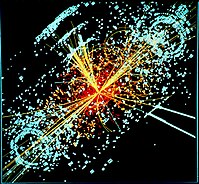
Photo from wikipedia
A bstractCollider search for dark matter production has been performed over the years based on high pT standard model signatures balanced by large missing transverse energy. The mono-Z boson production… Click to show full abstract
A bstractCollider search for dark matter production has been performed over the years based on high pT standard model signatures balanced by large missing transverse energy. The mono-Z boson production with leptonic decay has a clean signature with the advantage that the decaying electrons and muons can be precisely measured. This signature not only enables reconstruction of the Z boson rest frame, but also makes possible recovery of the underlying production dynamics through the decaying lepton angular distribution. In this work, we exploit full information carried by the leptonic Z boson decays to set limits on coupling strength parameters of the dark sector. We study simplified dark sector models with scalar, vector, and tensor mediators and observe among them different signatures in the distribution of angular coefficients. Specifically, we show that angular coefficients can be used to distinguish different scenarios of the spin-0 and spin-1 models, including the ones with parity-odd and charge conjugation parity-odd operators. To maximize the statistical power, we perform a matrix element method study with a dynamic construction of event likelihood function. We parametrize the test statistic such that sensitivity from the matrix element is quantified through a term measuring the shape difference. Our results show that the shape differences provide significant improvements in the limits, especially for the scalar mediator models. We also present an example application of a matrix-element-kinematic-discriminator, an easier approach that is applicable for experimental data.
Journal Title: Journal of High Energy Physics
Year Published: 2017
Link to full text (if available)
Share on Social Media: Sign Up to like & get
recommendations!